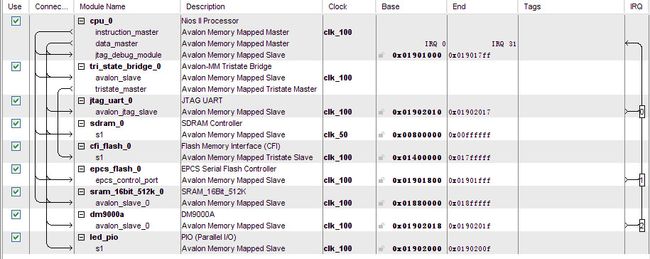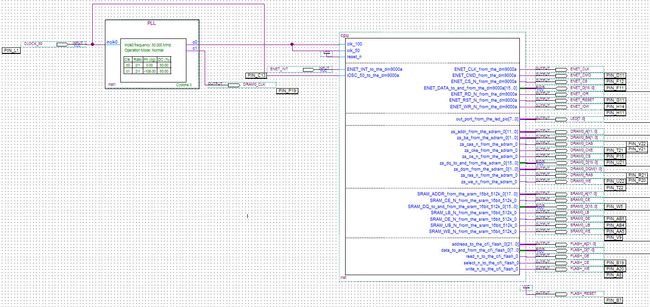DIY_DE2之DM9000A网卡调试系列例程(二)——DM9000A测试、自收发、实现UDP
一、摘要
通过在SOPC中定制软核,在Quartus II中建立硬件工程,然后在NIOS II中建立3个工程,分别实现DM9000A测试、DM9000A自收发和基于DM9000A的UDP协议的例子。3个例子所使用的DM9000A的驱动是一样的。
二、实验平台
软件平台:Quartus II 9.0 + Nios II 9.0
硬件平台:DIY_DE2
三、实验内容1——>DM9000A测试
通过对DM9000A的初始化,测试DM9000A是否能够正常的初始化,能否正常的运行。该内容不需要使用网线。以下为实现步骤。
1、采用SOPC定制软核
定制软核的详细步骤不再赘述,以上为定制的软核。
cpu_0需要设置的地方:
Reset Vector:cfi_flash_0、
Exception Vector:sram_16bit_512k_0
第二个标签页:Data Master处,Data Cache设置为None
之后分配地址,分配中断号,生成即可。
2、硬件电路
采用原理图的形式,创建顶层文件。
(1)添加生成的软核;
(2)调用锁相环IP核;
(3)连线、分配管脚;
(4)编译、综合,生成配置文件。
最后原理图如下图所示。
需要注意的问题:
(1)软核程序在SDRAM里面运行,为了使软核的速度提升,因此SDRAM的频率和cpu的频率都设置为100M。cpu时钟clk_100和sdram操作时钟clk_50都接PLL的c0,100M,无相位偏移;SDRAM的时钟管脚SDRAM_CLK连接PLL的c1,100M,偏移-3ns。
(2)DM9000A的时钟管脚接50M,直接连接晶振的输入端即可。
(3)复位管脚接高电平VCC即可。
(4)CFI_FLASH的复位管脚FLASH_RESET接高电平VCC即可。
3、软件方面
(1)打开NIOS II,新建工程,调用一个空的工程模板。
(2)添加DM9000A驱动:dm9000a.h和dm9000a.c,将上述两个文件包括basic_io复制到上步建立的工程文件夹下。见附录。
(3)添加一个新的.c文件,命名为main.c。将下列代码复制到main.c内。
main.c文件
- #include "basic_io.h"
- #include "DM9000A.C"
- int main()
- {
- unsigned int a;
- a=DM9000_init();
- DM9000_init(); // initialize DM9000 LAN chip //
- if(!a)
- {
- printf("Success");
- // TransmitPacket(unsigned char *data_ptr,unsigned int tx_len);
- // ReceivePacket (unsigned char *data_ptr,unsigned int *rx_len);
- }
- else
- printf("Failed");
- }
(4)编译、下载、运行,之前要先将.sof的配置文件下载到FPGA内。就可以看到RJ-45的黄色的灯和绿色的灯亮了起来。另外,在NIOS II的控制台Console中也能看到输出了 Success 。这时,说明DM9000A能正常运行,且初始化正常。
四、实验内容2——>实现DM9000A自收发
通过DM9000A将数据包发送出去,之后通过中断接收。需要使用到网线A。
不需要改动硬件系统,在上一步的基础上,直接在NOIS II中新建工程,添加main.c文件。
main.c文件内容如下:
- #include "basic_io.h"
- #include "DM9000A.C"
- #include "altera_avalon_pio_regs.h"
- unsigned int aaa,rx_len,i,packet_num;
- unsigned char RXT[68] = { 0xFF,0xFF,0xFF,0xFF,0xFF,0xFF,
- 0x01,0x60,0x6E,0x11,0x02,0x0F,
- 0x08,0x00,0x11,0x22,0x33,0x44,
- 0x55,0x66,0x77,0x88,0x99,0xAA,
- 0x55,0x66,0x77,0x88,0x99,0xAA,
- 0x55,0x66,0x77,0x88,0x99,0xAA,
- 0x55,0x66,0x77,0x88,0x99,0xAA,
- 0x55,0x66,0x77,0x88,0x99,0xAA,
- 0x55,0x66,0x77,0x88,0x99,0xAA,
- 0x55,0x66,0x77,0x88,0x99,0xAA,
- 0x00,0x00,0x00,0x20 };
- void ethernet_interrupts()
- {
- packet_num++;
- aaa=ReceivePacket (RXT,&rx_len);
- if(!aaa)
- {
- printf("\n\nReceive Packet Length = %d",rx_len);
- for(i=0;i<rx_len;i++)
- {
- if(i%8==0)
- printf("\n");
- printf("0x%2X,",RXT[i]);
- if(RXT[i] == 0x3f)
- IOWR_ALTERA_AVALON_PIO_DATA(LED_PIO_BASE, 0xff);
- }
- }
- }
- int main(void)
- {
- unsigned char TXT[] = { 0xFF,0xFF,0xFF,0xFF,0xFF,0xFF,
- 0x01,0x60,0x6E,0x11,0x02,0x0F,
- 0x08,0x00,0x11,0x22,0x33,0x44,
- 0x55,0x66,0x77,0x88,0x99,0xAA,
- 0x55,0x66,0x77,0x88,0x99,0xAA,
- 0x55,0x66,0x77,0x88,0x99,0xAA,
- 0x55,0x66,0x77,0x88,0x99,0xAA,
- 0x55,0x66,0x77,0x88,0x99,0xAA,
- 0x55,0x66,0x77,0x88,0x99,0xAA,
- 0x55,0x66,0x77,0x88,0x99,0xAA,
- 0x00,0x00,0x00,0x20 };
- DM9000_init();
- alt_irq_register( DM9000A_IRQ, NULL, (void*)ethernet_interrupts );
- packet_num=0;
- while (1)
- {
- TransmitPacket(TXT,0x40);
- msleep(500);
- }
- return 0;
- }
- //
- //-------------------------------------------------------------------------
编译、下载、运行。这时候将网线A插入DIY_DE2开发板的RJ-45,能够看到黄色的灯闪烁,绿色的灯一直亮,另外,在NIOS II控制台也能看到收到的数据。
五、简单UDP协议的实现
DM9000A与PC的简单通信,采用UDP协议,用B网线连接DIY_DE2与PC。FPGA内部产生递增数据,够一个数据包后,通过网络将数据传输给PC,PC也可以通过网络给FPGA发送数据,FPGA则通过中断接收数据。
同样,直接在NOIS II中新建工程,添加main.c文件。
可以使用Wireshark软件来捕捉数据包,并测试其传输速度。经过测试:
cpu采用100MHz时,
(1)cpu/e:SRAM运行,速度3Mbps;
SDRAM运行,50MHz时,速度600Kbps;
SDRAM运行,100MHz时,速度1.0Mbps;
(2)cpu/f:SRAM运行,速度11Mbps。
main.c文件内容如下:
- main.c文件
- #include <io.h>
- #include <stdio.h>
- #include <unistd.h>
- #include <stdlib.h>
- #include <string.h>
- #include "system.h"
- #include "DM9000A.C"
- unsigned int aaa,rx_len,i,counter;
- unsigned char RXT[70];
- unsigned int IPsource_1,IPsource_2,IPsource_3,IPsource_4;
- unsigned int IPdestination_1,IPdestination_2,IPdestination_3,IPdestination_4;
- unsigned int IPchecksum1,IPchecksum2,IPchecksum3,IPchecksum4,IPchecksum5;
- unsigned int Mac_source1, Mac_source2, Mac_source3, Mac_source4, Mac_source5, Mac_source6;
- unsigned int Mac_dest1, Mac_dest2, Mac_dest3, Mac_dest4, Mac_dest5, Mac_dest6;
- unsigned int times, lenght_h, lenght_l;
- unsigned int flenght, IPlenght_h, IPlenght_l, data_lenght, IPlenght;
- /*
- // Next step try to recieve packets. (not available now).
- void ethernet_interrupts()
- {
- aaa=ReceivePacket (RXT,&rx_len);
- if(!aaa)
- {
- printf("\n\nReceive Packet Length = %d",rx_len);
- for(i=0;i<rx_len;i++)
- {
- if(i%8==0)
- printf("\n");
- printf("0x%2X,",RXT[i]);
- }
- }
- }
- */
- int main(void)
- {
- IPsource_1 = 0xC0; // Assign ie: 192.168.0.44 IP for the DE2
- IPsource_2 = 0xA8;
- IPsource_3 = 0x00;
- IPsource_4 = 0x2C;
- IPdestination_1 = 0xCA; // Insert your IP data here
- IPdestination_2 = 0x76;
- IPdestination_3 = 0xBB;
- IPdestination_4 = 0x57;
- Mac_dest1 = 0x00; // Insert your MAC address data here
- Mac_dest2 = 0x0F;
- Mac_dest3 = 0xEA;
- Mac_dest4 = 0xFD;
- Mac_dest5 = 0x9F;
- Mac_dest6 = 0x96;
- Mac_source1 = 0x01; // Assign an MAC address for DE2
- Mac_source2 = 0x60;
- Mac_source3 = 0x6E;
- Mac_source4 = 0x11;
- Mac_source5 = 0x02;
- Mac_source6 = 0x0F;
- data_lenght = 1468; // Maximun Data lenght 1468 bytes
- flenght = data_lenght + 0x2E; //Total packet lenght
- lenght_h = ((data_lenght+8) & 0xFF00)>>8; // Convert in H byte and L byte
- lenght_l = ((data_lenght+8) & 0x00FF);
- IPlenght = data_lenght + 8 + 20; // IP Lenght for IP header
- IPlenght_h = (IPlenght & 0xFF00)>>8; // Convert in H byte and L byte
- IPlenght_l = (IPlenght & 0x00FF);
- // Calculating the IP checksum
- IPchecksum1 = 0x0000C511 + (IPsource_1<<8)+IPsource_2+(IPsource_3<<8)+IPsource_4+
- (IPdestination_1<<8)+IPdestination_2+(IPdestination_3<<8)+(IPdestination_4)+
- (IPlenght_h<<8) + IPlenght_l;
- IPchecksum2 = ((IPchecksum1&0x0000FFFF)+(IPchecksum1>>16));
- IPchecksum3 = 0x0000FFFF - IPchecksum2;
- IPchecksum4 = (IPchecksum3 & 0xFF00)>>8;
- IPchecksum5 = (IPchecksum3 & 0x00FF);
- unsigned char SND[flenght]; // Payload buffer
- unsigned char TXT[] = { Mac_dest1, Mac_dest2, Mac_dest3, Mac_dest4 ,Mac_dest5, Mac_dest6,
- Mac_source1, Mac_source2, Mac_source3, Mac_source4, Mac_source5, Mac_source6,
- 0x08, 0x00, 0x45, 0x00, IPlenght_h, IPlenght_l,
- 0x00, 0x00, 0x00, 0x00, 0x80, 0x11,
- IPchecksum4, IPchecksum5, IPsource_1, IPsource_2, IPsource_3, IPsource_4,
- IPdestination_1, IPdestination_2, IPdestination_3, IPdestination_4, 0x04, 0x00,
- 0x04, 0x00, lenght_h, lenght_l, 0x00, 0x00};
- for (i = 0; i < 42; i++) // Load the TXT[] in the SND (ethernet packet).
- SND[i] = TXT[i];
- for (i = 42; i < flenght-4; i++) // generating the data to send.
- SND[i] = i-42;
- SND[i++] = 0x35; // This checksum is not correct... but also the net recieve the packets correctly.
- SND[i++] = 0x15; // To do, calculate checksum.
- SND[i++] = 0xF0;
- SND[i++] = 0x13;
- DM9000_init(); // Initialize the DM9000A.
- // Next step try to recieve packets.(not available now).
- // alt_irq_register( DM9000A_IRQ, NULL, (void*)ethernet_interrupts );
- while (1)
- {
- TransmitPacket(SND,flenght); // Send repetitively 1468 bytes of data.
- // printf("0x%2X,",ior(NSR)); // For check if 10Mbps or 100Mbps active, 0x80 = 10Mbps, 0x40 = 100Mbps.
- // may happend an RX overflow buffer = 0x42
- // msleep(500);
- }
- return 0;
- }
-
//---------------------------------------------------------------
六、说明
UDP属于无连接的通信,这里不必把本机和DE2的IP设置成同一网段,即可完成通信。

